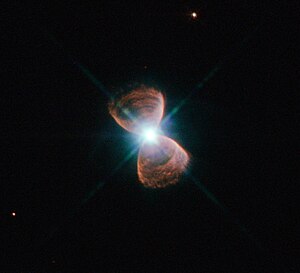双極性星雲

双極性星雲(Bipolar nebula)は、軸対称な1対のローブを持つように見える星雲である。
全てではないが多くの惑星状星雲では、双極性の構造が観測される。恐らく、2種類の星雲が相互作用し、進化の過程で一方が他方に優先するようになったものであろうと考えられている。
形成
[編集]この星雲の構造の正確な起源は分かっていないが、恒星が両極に沿って高エネルギーの流れを噴き出す双極流出(Bipolar outflow)として知られる物理過程と関連があると考えられている。ある理論では、これらの流出が恒星の周りの物質と衝突するとする。
例
[編集]
- りゅうこつ座η星の周りの人形星雲[2][3][4][5]
- ハッブル5[6]
- M2-9[7][8][9]
- ひょうたん星雲(腐った卵星雲)[10][11][11][12][13]
- Mz 3[14][15][16]
- 卵星雲[17][18][19][20]
- 赤い長方形星雲[21][22][23]
- 砂時計星雲[24][25][26][27][28]
- Southern Crab Nebula[29][30][31]
- ブーメラン星雲[32][33][34][35][36]
- NGC 2346[37]
出典
[編集]- ^ “Bizarre alignment of planetary nebulae”. ESA/Hubble Press Release 6 September 2013閲覧。
- ^ NewsCenter - Doomed Star Eta Carinae (06/10/1996) - Release Images. HubbleSite (10 June 1996). Retrieved on 2010-11-26.
- ^ APOD: 12 July 1995 - Eta Carinae Before Explosion. Antwrp.gsfc.nasa.gov (12 July 1995). Retrieved on 2010-11-26.
- ^ APOD: 2006 March 26 - Doomed Star Eta Carinae. Antwrp.gsfc.nasa.gov. Retrieved on 2010-11-26.
- ^ Eta Carinae Nebula (NGC 3372). Daviddarling.info (1 February 2007). Retrieved on 2010-11-26.
- ^ HubbleSite – NewsCenter – Hubble Witnesses the Final Blaze of Glory of Sun-Like Stars (12/17/1997) – Release Images
- ^ APOD: 2005 June 12 - M2 9: Wings of a Butterfly Nebula. Antwrp.gsfc.nasa.gov. Retrieved on 2010-11-26.
- ^ APOD: 21 October 1997 - The Butterfly Planetary Nebula. Antwrp.gsfc.nasa.gov (21 October 1997). Retrieved on 2010-11-26.
- ^ Butterfly Nebula (M 2-9). Daviddarling.info (1 February 2007). Retrieved on 2010-11-26.
- ^ NewsCenter - The "Rotten Egg" Nebula: A Planetary Nebula in the Making (10/19/1999) - Introduction. HubbleSite (19 October 1999). Retrieved on 2010-11-26.
- ^ a b APOD: 1 November 1999 - The Rotten Egg Planetary Nebula. Antwrp.gsfc.nasa.gov (1 November 1999). Retrieved on 2010-11-26.
- ^ APOD: 2001 September 3 - The Making of the Rotten Egg Nebula. Antwrp.gsfc.nasa.gov. Retrieved on 2010-11-26.
- ^ Calabash Nebula (OH231.8+4.2). Daviddarling.info (1 February 2007). Retrieved on 2010-11-26.
- ^ NewsCenter - Astro-Entomology? Ant-like Space Structure Previews Death of Our Sun (02/01/2001) - Introduction. HubbleSite (1 February 2001). Retrieved on 2010-11-26.
- ^ APOD: 2005 May 1 - Planetary Nebula Mz3: The Ant Nebula. Antwrp.gsfc.nasa.gov. Retrieved on 2010-11-26.
- ^ Ant Nebula (Menzel 3). Daviddarling.info (1 February 2007). Retrieved on 2010-11-26.
- ^ NewsCenter - Hubble Finds Searchlight Beams and Multiple Arcs around a Dying Star (01/16/1996) - Introduction. HubbleSite (16 January 1996). Retrieved on 2010-11-26.
- ^ APOD: 26 June 1999 - Shells in the Egg Nebula. Antwrp.gsfc.nasa.gov (26 June 1999). Retrieved on 2010-11-26.
- ^ APOD: 2003 April 9 - The Egg Nebula in Polarized Light. Antwrp.gsfc.nasa.gov. Retrieved on 2010-11-26.
- ^ Egg Nebula (CRL 2688). Daviddarling.info (1 February 2007). Retrieved on 2010-11-26.
- ^ NewsCenter - Dying Star Sculpts Rungs of Gas and Dust (05/11/2004) - Release Images. HubbleSite (11 May 2004). Retrieved on 2010-11-26.
- ^ APOD: 2004 May 13 - Rungs of the Red Rectangle. Antwrp.gsfc.nasa.gov. Retrieved on 2010-11-26.
- ^ Red Rectangle. Daviddarling.info (1 February 2007). Retrieved on 2010-11-26.
- ^ NewsCenter - Hubble Finds an Hourglass Nebula around a Dying Star (01/16/1996) - Release Images. HubbleSite (16 January 1996). Retrieved on 2010-11-26.
- ^ APOD: 18 January 1996 - MyCn18: An Hourglass Nebula. Antwrp.gsfc.nasa.gov (18 January 1996). Retrieved on 2010-11-26.
- ^ APOD: 2002 June 15 - MyCn18: An Hourglass Nebula. Antwrp.gsfc.nasa.gov. Retrieved on 2010-11-26.
- ^ APOD: 9 February 1996 - The Eye of an Hourglass Nebula. Antwrp.gsfc.nasa.gov (9 February 1996). Retrieved on 2010-11-26.
- ^ Hourglass Nebula (MyCn 18). Daviddarling.info (1 February 2007). Retrieved on 2010-11-26.
- ^ NewsCenter - Symbiotic Star Blows Bubbles into Space (08/24/1999) - Release Images. HubbleSite (24 August 1999). Retrieved on 2010-11-26.
- ^ APOD: 31 August 1999 - Symbiotic Star Bubbles. Antwrp.gsfc.nasa.gov (31 August 1999). Retrieved on 2010-11-26.
- ^ Southern Crab Nebula (He2-104). Daviddarling.info (1 February 2007). Retrieved on 2010-11-26.
- ^ NewsCenter - Hubble Catches Scattered Light from the Boomerang Nebula (09/13/2005) - Release Images. HubbleSite (13 September 2005). Retrieved on 2010-11-26.
- ^ APOD: 2005 September 14 - The Boomerang Nebula in Polarized Light. Antwrp.gsfc.nasa.gov. Retrieved on 2010-11-26.
- ^ APOD: 2003 February 20 - Cold Wind from the Boomerang Nebula. Antwrp.gsfc.nasa.gov. Retrieved on 2010-11-26.
- ^ APOD: 15 October 1997 - Cold Wind From The Boomerang Nebula. Antwrp.gsfc.nasa.gov (15 October 1997). Retrieved on 2010-11-26.
- ^ Boomerang Nebula. Daviddarling.info (1 February 2007). Retrieved on 2010-11-26.
- ^ APOD: 28 October 2001 – NGC 2346: A Butterfly-Shaped Planetary Nebula
関連項目
[編集]- 双極流出
- 恒星進化論
Text is available under the CC BY-SA 4.0 license; additional terms may apply.
Images, videos and audio are available under their respective licenses.
